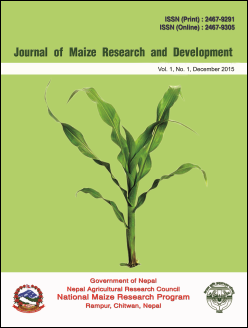Survey on maize post-harvest losses and its management practices in the western hills of Nepal
DOI:
https://doi.org/10.3126/jmrd.v1i1.14247Keywords:
Maize, Weevil, Infestation, Storage, Post-harvest lossesAbstract
A survey was conducted in order to assess the losses of maize under farmers’ storage conditions in the Western hills of Nepal in 2014. The survey area included Thanapati Village Development Committee (VDC) of Gulmi, Aalamdebi VDC of Syangja, Khasauli VDC of Palpa and Baglung municipality-12, Baglung district. Primary information was collected through semi-structured questionnaires among the heterogenous groups of the farming communities. Survey revealed that about 61% respondents reported the storage pest as the major pests and about 12% respondents reported that field pests as the major pests in the western hills. Maize weevil (Sitophylus zeamais Mostsch.) and Angoumois grain moth (Sitotroga cerealella Oliv.) were found to be major storage insect pests in surveyed areas. Majority of respondents (39%) presumed on 10-20% losses during storage. Among the other biotic factors, farmers ranked insect (42%), weeds (32%) and diseases (17%) respectively. Maize storage methods had distinct among the surveyed areas compared with Baglung district to other surveyed areas. In Baglung, about (73%) farmers had stored maize in the form of grain whereas in Palpa, Gulmi and Syangja, about (77%) farmers had practice of storing maize with husk for 5-7 months. Approximately, 40% respondents were using open floor in upper stair “Aanti”as a major maize storage place in Palpa, Gulmi and Syangja whereas almost (79%) of respondents were using sacks to store shelled grains in Baglung. Hence, there is ample opportunity to reduce the storage losses of maize depending upon the existing situation.
Journal of Maize Research and Development (2015) 1(1):98-105




